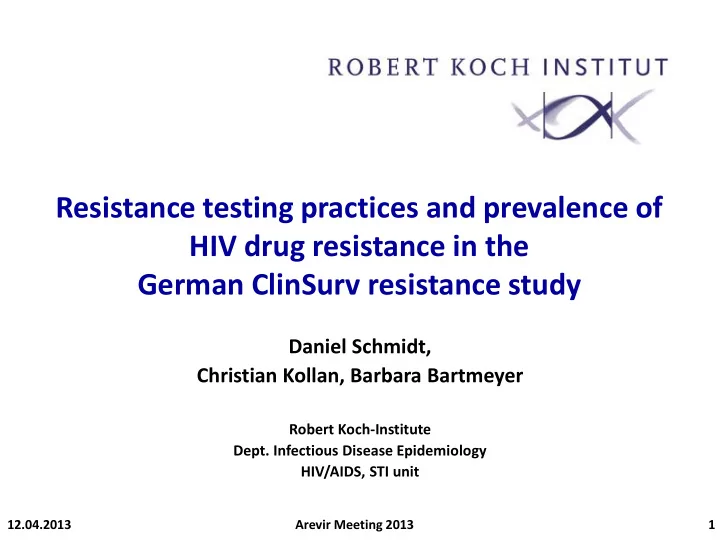

Resistance testing practices and prevalence of HIV drug resistance in the German ClinSurv resistance study Daniel Schmidt, Christian Kollan, Barbara Bartmeyer Robert Koch-Institute Dept. Infectious Disease Epidemiology HIV/AIDS, STI unit 12.04.2013 Arevir Meeting 2013 1
HIV resistance surveillance - status quo in Germany Genotyping financed by statutory health insurances prior to first line • treatment and in case of treatment failure No resistance data through mandatory HIV reporting • HIV drug resistance monitoring only in observational studies • No information about prevalence of HIV resistance on population level • No central repository for HIV sequence data exists • - storage of viral sequences in different labs At national level lack of knowledge: • - on data process algorithms in clinical settings - frequency of resistance testing - date of sampling vs. date of sequencing - reasons for resistance testing of treatment experienced patients Pilot resistance study within the ClinSurv cohort to gain information about HIV resistance in an unselected population 2
The ClinSurv cohort Cohort design/Treatment status • Open, multi centre observational study cohort (since 1999) • 15 study centres throughout Germany • Only basic data recorded (VL, CD4, AIDS diagnoses, ART) → no written informed consent required • Total study population (31.12.2011): 16,974 patients (113,825 years of observation) • 9,066 patients on ART per quarter of observation • 172 patients ART initiation per quarter of observation • Successful treatment: >80% of patients, without blips >90% (VL <50 copies/ml, observation time >90 days of treatment) 3
ClinSurv HIV Resistance study ClinSurv HIV N=16,974 ClinSurv Resistance Study N=9,528 (56% of ClinSurv patients) Pilot sites Genotyped 34% (3,267/9,528) Cologne Sequences N=4,989 Dusseldorf Treatment status of patients while Hamburg genotyped: Hannover 47% therapy naive; 50% ART experienced Munich 4
ClinSurv HIV Resistance study - Methods Identification of ClinSurv patients with available sequences at local sites Replacement of local sample count numbers by pseudonymized identifiers Process through Stanford Interpretation algorithm; HIV db version 6.1.1F; 2012 Epidemiological analysis by using different lists of mutations (SDRM list 2009; IAS list 2011) 5
Patient characteristics N=3,267 • Gender: 82% Men • Transmission risk: 58% MSM, 14% Hetero, 12% HPC, 6% IDU • Origin: 74% Germany, 12% Africa & Near East • Subtype: 79% HIV-B, 10% HIV-A, 5% CRF, 3% HIV-C • Transmission risk, origin, HIV subtype differed between men and women − Women: Origin: 40% Germany, 40% Africa, Near East Risk: 46% HPC, 34% Hetero, 11% IDU, Subtype: 38% HIV-B, 28% HIV-A, 14% CRF, 11% HIV-C 6
Resistance testing practices Testing frequencies • 80% of resistance tests were performed after 2005 • Resistance testing frequency: 74% one single test, 16% two tests, 5% three tests • Time between resistance tests decreased (median: 348 days) Testing and treatment • 8% of patients started treatment before 1996, 62% of patients started treatment after 2004 • Treatment start in 48% within 4 weeks after first resistance test (median 33days) • 60% of patients were exposed to antiretroviral drugs for more than 5 years, 25% for more than 10 years 7
Prevalence of transmitted drug resistance TDR Total TDR NRTI resistance NNRTI resistance PI resistance 16,0% 14,0% 12,0% 10,0% 8,0% 6,0% 4,0% 2,0% 0,0% Prevalence of drug resistance in first Prot/RT sequences from treatment naive patients (n=1,950) by year according to Prevalence of TDR: 10.4% (95% CI 9.1-11.8) p for trend =0.6, 2001-2011 Overall prevalence 7% (95%CI 6-8; p=0.7) NRTI 3% (95%CI 2-4; p=0.6) NNRTI 3% (95%CI 2-4; p=0.7) PI 8 0% 5% 10%
Prevalence of acquired drug resistance ADR submitted for publication 9
Prevalence of ADR in different drug classes submitted for publication 10
Single mutations submitted for publication 11
Treatment exposure with protease inhibitors among treated patients submitted for publication 12
Viral load in sequences from treated patients submitted for publication 13
ClinSurv Resistance study - Conclusions • Prevalence of TDR stable over time (10%) • Significant decline of ADR over time • Broader resistance testing in the study population since coverage of resistance testing by health insurances • Treatment start in median within 4 weeks after first test • No trend to test at low level viraemia in the study population • High variety of PIs used for ART prescription Decline in ADR could be influenced by better treatment options, resistance test guided therapy and broader testing 14
ClinSurv Resistance study Participating sites University of Düsseldorf PD Dr. Björn Ole Jensen University of Cologne Prof. Dr. Gerd Fätkenheuer, Eugen Schülter University of Hannover Prof. Dr. Mathias Stoll University of Munich Prof. Dr. Johannes Bogner, Prof. Dr. Eberle ICH Study Centre Hamburg Prof. Dr. H.J. Stellbrink Robert Koch-Institute FG 18 Karolin Meixenberger, Claudia Kücherer FG34 Andrea Kühne, Bernd Reinhardt, Osamah Hamouda 15
Recommend
More recommend